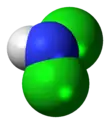Dichloramine
Dichloramine is a reactive inorganic compound. It has the formula NHCl2. The yellow gas is unstable and reacts with many materials.[1] It is formed by a reaction between ammonia and chlorine or sodium hypochlorite. It is a byproduct formed during the synthesis of monochloramine and nitrogen trichloride.
| |||
| Names | |||
|---|---|---|---|
| Other names
Chlorimide | |||
| Identifiers | |||
| |||
3D model (JSmol) |
|||
| ChemSpider | |||
PubChem CID |
|||
| UNII | |||
CompTox Dashboard (EPA) |
|||
| |||
| |||
| Properties | |||
| Cl2HN | |||
| Molar mass | 85.92 g·mol−1 | ||
| Appearance | yellow gas[1] | ||
Except where otherwise noted, data are given for materials in their standard state (at 25 °C [77 °F], 100 kPa). | |||
| Infobox references | |||
Synthesis
Dichloramine can be prepared by a reaction between monochloramine and chlorine or sodium hypochlorite:[1]
- NH2Cl + Cl2 → NHCl2 + HCl
Reaction
Dichloramine reacts with hydroxyl ion, which can be present in water or comes from water molecules, to yield nitroxyl radical and the chloride ion.[2]
References
This article is issued from Wikipedia. The text is licensed under Creative Commons - Attribution - Sharealike. Additional terms may apply for the media files.


